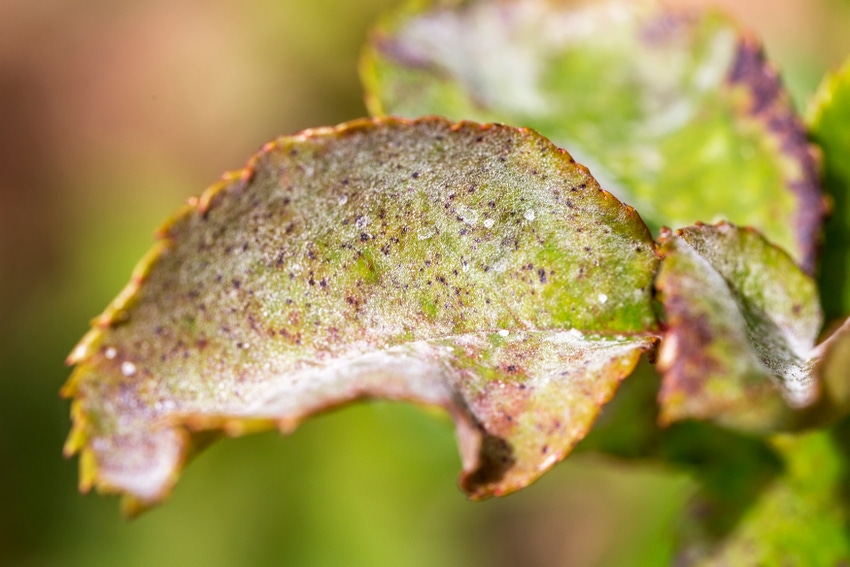
California growers were using sulfur to battle powdery mildew before the first synthetic fungicides were introduced to control the disease in the early 1980s. But, that doesn’t make this elemental material any less relevant for containing outbreaks of the disease today.
In fact, sulfur remains the go-to natural choice of organic growers for limiting powdery mildew damage, says Larry Bettiga, University of California Cooperative Extension viticulture advisor for Monterey County.
“The synthetic fungicides, especially the current ones, work quite well in controlling powdery mildew,” he says. “But sulfur still has a big role to play in protecting conventional vineyards from the disease.”
Unlike synthetic materials, natural sulfur carries no risk of disease-causing fungi developing resistance to it, Bettiga notes. And, it costs considerably less than synthetic products. As a result, sulfur offers an affordable option where resistance may be developing in a vineyard.
“If you’re seeing some slippage in effectiveness of a synthetic fungicide, especially in the case of an older product, including sulfur in your powdery mildew program may help control those more resistant isolates of the fungi,” Bettiga says.
In some cases, sulfur may have proven beneficial for growers who relied heavily on synthetic fungicides to control last year’s unusually high powdery mildew pressures, he notes. “Along with additional leaf pulling and canopy hedging to improve air circulation and treatment coverage, adding sulfur to the tank may have improved control where growers experienced some decline in effectiveness of a synthetic product,” Bettiga adds.
Recent research by scientists at Cornell University refute the contention of some in the wine industry that excess levels of sulfur residue on the fruit at harvest can disrupt the fermentation process, producing sulfides that harm the quality of the wine.
These studies show that when sulfur is used only up until veraison, the point where increasing sugar levels begin to inhibit development of powdery mildew, any sulfides in the wine are often caused by poor nutrition of the must. This stresses the yeasts, which can cause them to produce sulfides, Bettiga said.
When sulfur use stopped after veraison, the level of elemental sulfur in must was found to be below the 10 mg/L threshold. That threshold is the level at which the potential for sulfide production resulting from applications of sulfur increases, Bettiga said.
Like any fungicide, except oil, sulfur is best used by applying it in advance of any outbreak of powdery mildew to protect against the disease rather than to eradicate it after the disease has already infected the vines, Bettiga notes.
Also, as with other soft chemistry materials, intervals between sulfur applications need to be reduced when disease pressure is high to maintain disease control. “Sulfur can maintain disease control if applied frequently enough with good coverage,” he says.
Sulfur kills the disease-spreading spores by disrupting respiration within their cells. It does this either by residual action or, at higher temperatures, by volatilization. Residual action requires direct contact with the spores.
What’s more, contrary to what some growers may think, researchers at Cornell University and in Australia found that sulfur does help control powdery mildew during the colder temperatures of spring.
“The key to using sulfur effectively under these conditions is to increase application rates and improve coverage of the green tissue you’re trying to protect,” Bettiga says. “If you do that, sulfur is still pretty effective at lower temperatures.”
Sulfur is available as a dust or in such sprayable forms as a wettable powder, a liquid flowable and a micronized dry flowable.
Of these, the dust form is the most economical treatment, Bettiga notes. He estimates the application cost of a dust treatment at about $8 per acre compared to around $17 to $20 per acre for a spray application.
“You can treat a lot more acres in the same amount of time using a duster rather than spraying a liquid, because a sprayer requires a slower ground speed to get the same degree of coverage as a duster,” Bettiga says “Also, you can get better coverage in thick canopies where leaves are shingled with the dust than a spray.”
The dust form, supplemented with synthetic fungicides from bloom to fruit set, tends to be more popular for vineyards with lower profit margins, he notes. Use of the more expensive synthetic products is greater in the higher-value grapes.
One advantage of micronized dry flowable sulfur products is the smaller and tighter range of size of the particles compared to wettable powders. Sulfur dust has the largest average particle size.
“The smaller the sulfur particle size the more activity along the leaf surface of the vine,” Bettiga says.” Also, smaller particle sizes volatize at a little higher rate than larger ones.”
More information on using of sulfur and other fungicides, as well as the Powdery Mildew Risk Index, for controlling powdery mildew, is available at www.ipm.ucanr.edu
About the Author(s)
You May Also Like




